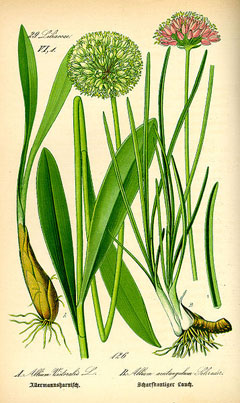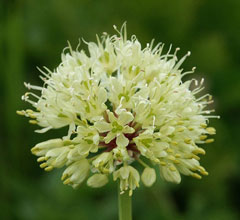 |
|
http://commons.wikimedia.org/wiki/File:Illustration_Allium_victoralis0.jpg |
 |
| http://commons.wikimedia.org/wiki/User:BerndH |
Translate this page:
Summary
Physical Characteristics

 Allium victorialis is a BULB growing to 0.6 m (2ft).
Allium victorialis is a BULB growing to 0.6 m (2ft).
See above for USDA hardiness. It is hardy to UK zone 7 and is not frost tender. It is in leaf from November to July, in flower in May, and the seeds ripen from June to July. The species is hermaphrodite (has both male and female organs) and is pollinated by Bees, insects.
Suitable for: light (sandy) and medium (loamy) soils and prefers well-drained soil. Suitable pH: mildly acid, neutral and basic (mildly alkaline) soils. It cannot grow in the shade. It prefers dry or moist soil.
UK Hardiness Map
US Hardiness Map
Synonyms
Plant Habitats
Cultivated Beds;
Edible Uses
Edible Parts: Flowers Leaves Root
Edible Uses:
Bulb - raw or cooked[183]. An onion substitute[22]. The plants are as pungent as garlic[203]. The bulbs are rather small, about 10 - 20mm in diameter, and are produced in clusters on a short rhizome[200]. Leaves - raw or cooked. The stems and leaves are eaten[177, 179], they are much favoured in Japan[116]. Flowers - raw or cooked.
References More on Edible Uses
Medicinal Uses
Plants For A Future can not take any responsibility for any adverse effects from the use of plants. Always seek advice from a professional before using a plant medicinally.
Antiscorbutic Carminative Diuretic Vermifuge Women's complaints
The root is antiscorbutic, carminative, diuretic and vermifuge[1, 46, 178, 218]. Used in the treatment of profuse menstruation[1, 46, 178].
References More on Medicinal Uses
The Bookshop: Edible Plant Books
Our Latest books on Perennial Plants For Food Forests and Permaculture Gardens in paperback or digital formats.

Edible Tropical Plants
Food Forest Plants for Hotter Conditions: 250+ Plants For Tropical Food Forests & Permaculture Gardens.
More

Edible Temperate Plants
Plants for Your Food Forest: 500 Plants for Temperate Food Forests & Permaculture Gardens.
More

More Books
PFAF have eight books available in paperback and digital formats. Browse the shop for more information.
Shop Now
Other Uses
Repellent
The juice of the plant is used as a moth repellent. The whole plant is said to repel insects and moles[20].
Special Uses
References More on Other Uses
Cultivation details
Requires a sunny position in a light well-drained soil[1, 200]. The bulbs should be planted fairly deeply[1]. Most members of this genus are intolerant of competition from other growing plants[203]. Grows well with most plants, especially roses, carrots, beet and chamomile, but it inhibits the growth of legumes[18, 20, 54]. This plant is a bad companion for alfalfa, each species negatively affecting the other[201]. Members of this genus are rarely if ever troubled by browsing deer[233].
References Carbon Farming Information and Carbon Sequestration Information
Temperature Converter
Type a value in the Celsius field to convert the value to Fahrenheit:
Fahrenheit:
The PFAF Bookshop
Plants For A Future have a number of books available in paperback and digital form. Book titles include Edible Plants, Edible Perennials, Edible Trees,Edible Shrubs, Woodland Gardening, and Temperate Food Forest Plants. Our new book is Food Forest Plants For Hotter Conditions (Tropical and Sub-Tropical).
Shop Now
Plant Propagation
Seed - best sown as soon as it is ripe in a greenhouse or cold frame. It germinates quickly and can be grown on in the greenhouse for the first year, planting out the dormant bulbs in the late summer of the following year if they have developed sufficiently, otherwise grow on in pots for a further year. Stored seed can be sown in spring in a greenhouse. Division in summer after the plants have died down. Fairly easy, though we have found that it is best to pot up the divisions until they are growing away strongly before planting them out into their permanent positions[K].
Other Names
If available other names are mentioned here
Native Range
TEMPERATE ASIA: Russian Federation-Ciscaucasia (Ciscaucasia), Russian Federation (Dagestan), Russian Federation (Buryatia, Gorno-Altay, Tyva, Respublika, Altay, Krasnoyarsk, Chita, Irkutsk, Kemerovskaja oblast, Novosibirsk, Sverdlovsk, Tomsk, Tyumen), Kazakhstan (east), Mongolia, Russian Federation (Kurile Islands, Habarovskij kraj, Primorye, Amur, Kamcatskij kraj, Sakhalin), China (Anhui Sheng, Zhejiang Sheng, Heilongjiang Sheng, Henan Sheng, Hebei Sheng, Hubei Sheng, Gansu Sheng (east), Jilin Sheng, Liaoning Sheng, Shanxi Sheng, Shaanxi Sheng, Sichuan Sheng, Nei Mongol Zizhiqu), Japan (Hokkaidô, Honshu), Korea, South TROPICAL ASIA: India (Sikkim, Himachal Pradesh, Jammu and Kashmir, Uttar Pradesh), Nepal NORTHERN AMERICA: United States (Alaska (Attu Island)) EUROPE: Austria, Switzerland, Czech Republic, Germany, Hungary, Poland, Slovakia, Former Yugoslavia, Bulgaria, Italy, Romania, Spain, France, Portugal
Weed Potential
Right plant wrong place. We are currently updating this section.
Please note that a plant may be invasive in one area but may not in your area so it's worth checking.
Conservation Status
IUCN Red List of Threatened Plants Status :

| Related Plants
|
| Latin Name | Common Name | Habit | Height | Hardiness | Growth | Soil | Shade | Moisture | Edible | Medicinal | Other |
| Allium acuminatum | Hooker's Onion, Tapertip onion | Bulb | 0.3 |
5-9
| | LM | N | DM | 3 | 2 | 2 |
| Allium aflatunense | Persian Onion, Ornamental Onion | Bulb | 1.0 |
4-8
| M | LM | N | M | 2 | 2 | 1 |
| Allium akaka | | Bulb | 0.2 |
7-10
| | LM | N | DM | 3 | 2 | 1 |
| Allium altaicum | | Bulb | 0.3 |
-
| | LM | N | M | 3 | 2 | 1 |
| Allium ampeloprasum | Wild Leek, Broadleaf wild leek | Bulb | 1.8 |
5-9
| | LMH | N | DM | 5 | 3 | 2 |
| Allium ampeloprasum babingtonii | Babington's Leek | Bulb | 1.8 |
0-0
| | LMH | N | DM | 3 | 3 | 2 |
| Allium angulare | | Bulb | 0.0 |
-
| | LM | N | M | 3 | 2 | 1 |
| Allium angulosum | Mouse Garlic | Bulb | 0.5 |
4-8
| | LMH | SN | M | 3 | 2 | 1 |
| Allium atropurpureum | | Bulb | 1.0 |
7-10
| | LM | SN | M | 3 | 2 | 1 |
| Allium bisceptrum | Aspen Onion, Twincrest onion | Bulb | 0.3 |
7-10
| | LM | N | M | 3 | 2 | 1 |
| Allium bodeanum | | Bulb | 0.2 |
-
| | LM | N | DM | 3 | 2 | 1 |
| Allium bolanderi | Bolander's Onion | Bulb | 0.2 |
6-9
| | LM | N | M | 3 | 2 | 1 |
| Allium brevistylum | Shortstyle Onion | Bulb | 0.5 |
-
| | LM | N | MWe | 3 | 2 | 1 |
| Allium canadense | Canadian Garlic, Meadow garlic, Fraser meadow garlic, Hyacinth meadow garlic | Bulb | 0.5 |
4-8
| | LM | SN | MWe | 4 | 2 | 2 |
| Allium canadense mobilense | Canadian Garlic | Bulb | 0.5 |
4-8
| | LM | SN | MWe | 5 | 2 | 1 |
| Allium carinatum | Keeled Garlic | Bulb | 0.6 |
6-9
| | LMH | SN | M | 3 | 2 | 1 |
| Allium carolinianum | | Bulb | 0.4 |
-
| | LM | N | DM | 3 | 2 | 1 |
| Allium cepa | Onion, Garden onion | Bulb | 0.6 |
4-10
| M | LM | N | M | 5 | 3 | 3 |
| Allium cepa aggregatum | Potato Onion | Bulb | 1.2 |
4-8
| M | LM | N | M | 4 | 3 | 3 |
| Allium cepa ascalonicum | Shallot | Bulb | 0.3 |
4-8
| | LM | N | M | 5 | 3 | 2 |
| Allium cepa proliferum | Tree Onion, Walking Onion | Bulb | 1.2 |
4-8
| M | LM | N | M | 5 | 3 | 3 |
| Allium cernuum | Nodding Onion, New Mexican nodding onion | Bulb | 0.5 |
5-9
| F | LMH | N | M | 5 | 2 | 2 |
| Allium chinense | Rakkyo | Bulb | 0.3 |
6-9
| | LM | N | M | 4 | 2 | 1 |
| Allium condensatum | | Bulb | 0.6 |
4-8
| | LM | N | M | 3 | 2 | 1 |
| Allium cupanii | | Bulb | 0.3 |
7-10
| | LM | N | DM | 3 | 2 | 1 |
| Allium douglasii | Douglas' Onion | Bulb | 0.3 |
0-0
| | LM | N | DM | 3 | 2 | 1 |
| Allium dregeanum | Wild Onion | Bulb | 0.6 |
-
| | LM | N | DM | 3 | 2 | 1 |
| Allium drummondii | Prairie Onion, Drummond's onion | Bulb | 0.3 |
6-9
| | LM | N | M | 3 | 2 | 1 |
| Allium fistulosum | Welsh Onion | Bulb | 0.6 |
5-9
| F | LMH | N | M | 5 | 2 | 2 |
| Allium flavum | Small Yellow Onion, Ornamental Onion | Bulb | 0.5 |
4-7
| M | LMH | SN | M | 2 | 2 | 1 |
|
|
Growth: S = slow M = medium F = fast. Soil: L = light (sandy) M = medium H = heavy (clay). pH: A = acid N = neutral B = basic (alkaline). Shade: F = full shade S = semi-shade N = no shade. Moisture: D = dry M = Moist We = wet Wa = water.
Now available:
Food Forest Plants for Mediterranean Conditions
350+ Perennial Plants For Mediterranean and Drier Food Forests and Permaculture Gardens.
[Paperback and eBook]
This is the third in Plants For A Future's series of plant guides for food forests tailored to
specific climate zones. Following volumes on temperate and tropical ecosystems, this book focuses
on species suited to Mediterranean conditions—regions with hot, dry summers and cool, wet winters,
often facing the added challenge of climate change.
Read More
Expert comment
Author
L.
Botanical References
45200266
Links / References
For a list of references used on this page please go here
Readers comment
| Add a comment |
|
If you have important information about this plant that may help other users please add a comment or link below. Only comments or links that are felt to be directly relevant to a plant will be included. If you think a comment/link or information contained on this page is inaccurate or misleading we would welcome your feedback at [email protected]. If you have questions about a plant please use the Forum on this website as we do not have the resources to answer questions ourselves.
* Please note: the comments by website users are not necessarily those held by PFAF and may give misleading or inaccurate information.
To leave a comment please Register or login here All comments need to be approved so will not appear immediately.
|
Subject : Allium victorialis
|
|
|
|